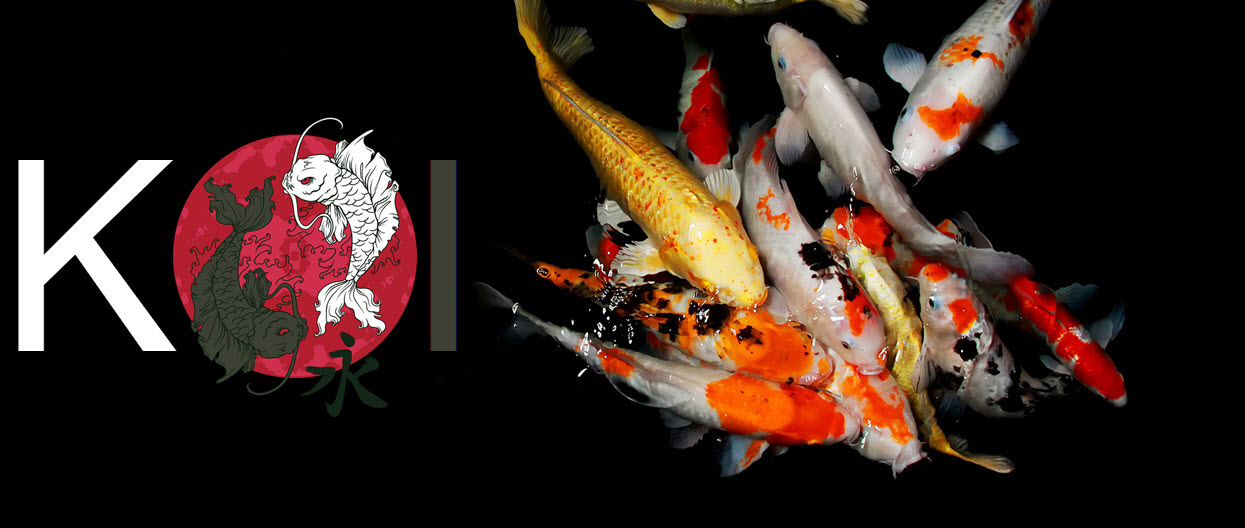The universe of Koi fish is a diverse, colorful one. In this article, we will look at a group of koi known as Utsuri Koi. As we delve into the captivating world of Utsuri Koi, we will explore their history, types, characteristics, and tips for their care and maintenance.
The Utsuri Koi, with its stunning color patterns and intriguing history, is indeed a unique gem, and it is not surprising that their beauty and charm has made them a favorite among many koi collectors and enthusiasts.
Owning these creatures involves – as always – a commitment to their care and maintenance. With the right environment and care, these swimming works of art can thrive, bringing joy and good vibes to their owners.

Short facts about Utsuri Koi
- Utsurimono (写り物) koi is black, with markings that are white, red or yellow.
- The yellow form is the oldest attested form. It was originally called Kuro Ki Madara (黒黄斑), which simply means “black and yellow markings” in Japanese, but the name was changed to Ki Utsuri by the prominent koi breeder Elizaburo Hoshino in the early 1900s.
- The version with red markings is called Hi Utsuri (緋写).
- The version with white markings is called Shiro Utsuri (白写).
Background
Koi, more officially named Nishikigoi, are coloured varieties of carp kept for ornamental purposes. Nishikigoi were developed in Japan from wild carps, and the word nishikigoi means brocaded carp in Japanese – a reference to their appearance.
The systematic breeding of ornamental carp in Japan commenced in the 1820s in the Nijūmuragō area of the Niigata Prefecture, on the northeastern coast of Honshu. At this point, Amur carp were already farmed as a food fish in parts of Niigata, and kept in rice paddies for pest control and to provide fertilizer.
During the Bunka and Bunsei eras (1804-1830), black, red, and white koi variants were bred in Nijūmuragō, and eventually, koi that were both red and white emerged as the result of cross-breeding. Why did koi breeding become so successful in Nijūmuragō? It was probably at least partly due to two reasons: 1.) A well-established tradition of raising carp as food fish already existed. 2.) The mountains in this region were hiding many secret rice fields that the lord did not know about, which helped the farmers avoid paying tax. Therefore, they could attain a somewhat better economic situation, which made it possible to engage in hobbies such as ornamental fish breeding.
In the 1870s, interest in keeping ornamental carps increased in Japan, and the number of breeders got a boost. During this era, some special koi variants began to fetch really high prices, but this resulted in a problem for the breeders in Nijūmuragō as the authorities in Niigata began to view koi breeding as a speculative business and consequently banned it. Fortunately for us modern koi aficionados, a petition from the villagers persuaded the authorities to lift the ban, and the koi breeding business was saved. At this point, the list of colored koi already included Ki Utsuri, Kōhaku, Asagi, and more.
Characteristics of Utsuri Koi
Though the color patterns are a primary identifier, the Utsuri Koi also present several other distinguishing characteristics. These fish showcase a strong, robust body shape, demonstrating excellent health and vitality. They can grow up to 3 feet in length, given the right conditions. Their eyes, often a point of fascination for Koi enthusiasts, are encircled by a black ‘bandit mask’ pattern. The balance between the black and other color patterns is a critical evaluation factor for Koi judges, indicating the fish’s quality and attractiveness.
Care and Maintenance of Utsuri Koi
Like all Koi fish, Utsuri Koi require a specific set of conditions to thrive. They need a clean, spacious environment with ample filtration, as they are known to produce significant amounts of waste. Regular water changes are a must to maintain the water’s quality unless you have a big enough pond with strong filtration.
In terms of feeding, Utsuri Koi are not fussy eaters. They enjoy a diet of commercial Koi pellets, fruits, and vegetables. It is essential to monitor their diet, as overeating can lead to health issues.
One key factor to remember is that Utsuri Koi, like other Koi fish, are sensitive to abrupt changes in water temperature, which can affect their health and color vibrancy.
